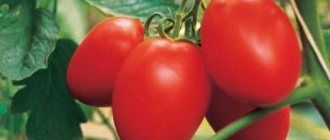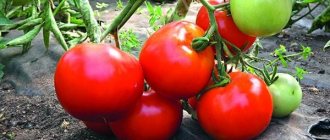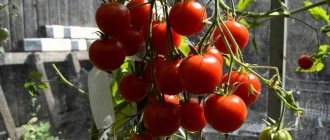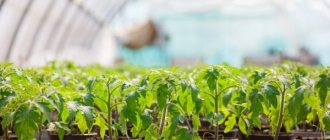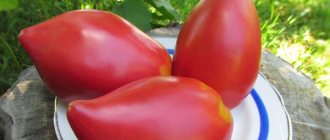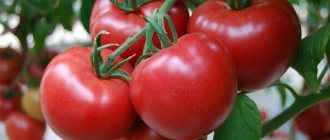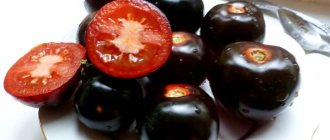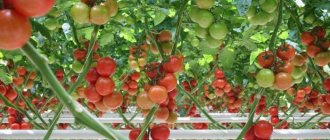- 4.1 Watering plantings
The Red Guard variety was bred by Ural breeders and was registered in 2012. The tomato is characterized by early ripening and is used for growing under cover in regions with cold climates.
Below are the characteristics, reviews and photos of who planted the Red Guard tomato. The variety is suitable for growing in the middle zone, the Ural and Siberian regions. These tomatoes are valued for their unpretentiousness, resistance to diseases and adverse conditions.
Description of the variety
The Red Guard variety bush has a number of features:
- superdeterminate variety;
- early ripening;
- 65 days pass from the moment of planting to harvesting the fruits;
- absence of stepchildren;
- increased resistance to diseases, pests and low temperatures.
According to the photo and description, Red Guard tomatoes have the following characteristics:
- round shape;
- there is slight ribbing;
- number of seed chambers – up to 6 pcs.;
- When ripe, the fruits acquire a bright red color;
- average tomato weight – 230 g;
- sugary and homogeneous pulp.
Description of the hybrid Red Guard f1
Determinate early ripening variety. Suitable for both greenhouses and open ground cultivation. The bush can reach a maximum height of 80cm and requires support.
The hybrid is resistant to lack of light and low temperatures. Ripens successfully in cool, short summer conditions. It also has high resistance to major diseases and pests.
Fruit characteristics and yield
The fruits are round, dense. The weight of each can reach 150-200 grams. When fully ripe, the vegetable is deep red in color. The pulp is fleshy, with good taste. The fruits do not crack, have a small number of seed chambers, have good shelf life and are suitable for transportation.
The purpose of the fruit is universal. If agricultural practices are followed, up to 3.5 kg of harvest can be harvested from one “Red Guard” tomato bush. From 7 to 9 fruits are usually formed on one brush.
Boarding order
Tomatoes are grown using the seedling method, which involves planting seeds at home. After two months, young plants are transferred to open areas or under cover. It is allowed to plant seeds directly into the soil, then the ripening period of vegetables will increase significantly.
Preparing seedlings
Tomato seedlings begin to be prepared at home. To do this, take soil consisting of equal amounts of garden soil and compost. It is allowed to use purchased mixtures intended for growing this crop. If soil from the site is used, it must be calcined in the oven for 15 minutes.
Advice! Before planting, it is recommended to wrap the seeds in a damp cloth for a day.
To disinfect the material, it is recommended to place it in a Fitosporin solution an hour before. If purchased seeds are brightly colored, then they do not need to be processed.
The soil is poured into shallow containers up to 15 cm high. The seeds are planted in furrows to a depth of 1 cm and covered with soil. To speed up the germination of tomatoes, it is recommended to keep containers in a dark place at a temperature of 25 degrees.
During development, seedlings are provided with lighting for 12 hours. Tomatoes are watered periodically.
Planting in a greenhouse
In greenhouse conditions, Red Guard tomatoes produce higher yields and are protected from adverse weather conditions. It is recommended to prepare the soil for planting in the fall. The top layer of soil (about 10 cm) is removed, since it often contains insect larvae and fungal spores.
In spring, dig up the soil and add compost. Plants are transferred to prepared holes. Their depth is 20-25 cm so that the root system can fit.
Advice! Red Guard tomatoes are planted at a distance of 40 cm from each other.
Since the bush of this variety is compact and low-growing, it does not require much space for normal development. After planting, the tomatoes are watered generously.
Planting in open ground
Two weeks before planting in open areas, they begin to harden the tomatoes. To do this, they are transferred to a balcony or loggia for several hours. Seedlings should be protected from drafts. Gradually, the period of exposure of tomatoes to fresh air is increased.
Tomatoes grow best in areas where legumes, cucumbers, turnips, cabbage, rutabaga, and onions were previously located. After tomatoes, replanting this crop is possible no earlier than three years later.
The soil for tomatoes in open areas begins to be prepared in the fall. It is carefully dug up, plant remains are removed, and compost is added.
Advice! In spring, the beds are loosened to a depth of 10 cm, after which the holes are prepared.
The tomatoes are placed in the depressions along with a lump of earth, covered with soil and watered abundantly. It is recommended to place plants at a distance of 40 cm from each other.
Planting seedlings in a permanent place
Planting takes place in mid-May, when the seedlings grow to 20–30 cm.
By this time, the greenhouse must meet the following requirements:
- the soil is updated, fertilized, weeds are removed;
- walls and ceilings are treated with copper sulfate for disinfection;
- there are no cracks in the material from which the greenhouse is made (film/glass);
- there is a window in the wall for ventilation;
- thermometer available.
Planted according to a certain pattern.
The conditions must also be met:
- The soil is warm (+15°C–+18°C), otherwise the roots will rot and will not take root.
- Seedlings are placed at the rate of 2–3 bushes per square meter. When planting in open ground, up to 4 bushes per square meter are allowed.
- The holes for planting should not be deeper than 20 cm, so that the sprinkled stem does not take new roots and does not slow down the growing season.
- The step between holes is 40 cm;
- The bushes are placed in a checkerboard pattern in 2 rows with a distance between rows of 50–60 cm.
- The ideal time to disembark is evening.
- After the plants are planted, they are watered abundantly with warm water.
Tomato care
The Red Guard tomato is easy to care for. Fruit ripening occurs even under unfavorable conditions: low temperature and lack of light. Because the crop ripens early, these tomatoes are rarely affected by fungal diseases.
The Red Guard variety is cared for by adding moisture and fertilizing. The plant is low-growing and does not require frequent pinching. The bush is formed into three stems, the excess branches are carefully broken off by hand.
It is recommended to tie tomatoes to simplify care and prevent the fruit from coming into contact with the ground. A support made of metal or wood is installed for each bush. Tomatoes are tied at the top.
Watering the plantings
Red Guard tomatoes require moderate watering, which is achieved by adding moisture weekly. In drought conditions, tomatoes are watered every three days.
About 4 liters of moisture are added under the bush. The soil moisture level is maintained at 85%. However, the air must remain dry, which in greenhouses is ensured by ventilation.
Advice! During the flowering period of tomatoes, the intensity of watering is increased by adding 5 liters of water under the bush weekly.
When the fruits ripen, tomatoes are watered twice a week. At the same time, do not use too much water so that the fruits do not crack. When the tomatoes begin to turn red, reduce watering to once a week.
Water for irrigation is collected in barrels. When it settles and warms up, it is used for its intended purpose. Moisture should not get on the green parts of plants, which often causes burns. It is poured strictly at the roots of plants.
Fertilizer application
With fertilizing, the Red Guard tomato develops normally and produces a good harvest. Plants are fed several times per season. It is recommended to alternate different types of fertilizing.
After planting the tomatoes, the first application of fertilizers is carried out after 2 weeks. At this stage of planting, they are fed with a urea solution (1 tbsp per bucket of water).
Advice! Excessive application of nitrogen activates the growth of tomatoes and negatively affects fruit formation.
A week after nitrogen feeding, you need to add potassium and phosphorus. 30 g of potassium sulfate and superphosphate are dissolved in 10 liters of water. Fertilizer is applied by watering. Ash, which is embedded in the soil, will help replace mineral fertilizers.
Among natural remedies, yeast feeding is considered effective. This fertilizer promotes the development of tomatoes, suppresses harmful microorganisms and helps the development of beneficial bacteria. It is used in the summer, when temperatures reach positive temperatures.
Yeast fertilizer is obtained from brewer's or baker's yeast. Take 0.1 kg of yeast per 10 liters of water, after which the mixture is infused. Sugar or old jam helps speed up the fermentation process.
During the fruiting period, you can feed the tomatoes by spraying. For 10 liters of water add 1 tbsp. l. superphosphate granules, it is necessary to spray the plantings leaf by leaf.
Advantages and disadvantages
The Red Guard variety is popular among tomato lovers. Its advantages include the following properties:
- high content of vitamins;
- early ripeness - no more than 90 days pass from the first shoots to the ripening of the fruit;
- superdeterminacy - the bush stops growing on its own after the formation of the fifth cluster;
- resistance to temperature changes and poor lighting;
- strong and pleasant aroma;
- fleshy, sugary fruit pulp;
- excellent taste, thanks to which the tomato belongs to the premium class;
- versatility in use.
See also
Description of the Tsar's Branch tomato, cultivation and yield of the variety
Read
Summer residents do not note any disadvantages in the variety. The only problem that the owner of the beds may encounter is the susceptibility of the bushes to whitefly.
Reviews from gardeners
Alisa, 25 years old, Moscow
I grew the Red Guard variety in a greenhouse. The tomatoes grew 1.2 m. The fruits looked very beautiful, although a little hard. Almost everyone went to canning. I have little experience in gardening; I haven’t particularly cared for tomatoes. I picked off the stepsons, watered them and fed them with ash a couple of times.
Igor, 62 years old, Ufa
The Red Guard variety was planted in open ground. I formed only the first brush, where I removed the stepsons. The bushes grew into 3-4 trunks. I was surprised by the abundant fruiting; the tomatoes themselves have a good taste. Ripening began in early July. When I threw out the bushes in the fall, there were still a lot of fruits left on them. Next year I will plant again, but I will use it only for harvesting.
Olesya, 38 years old, Ekaterinburg
The Red Guard chose tomatoes based on reviews and photos of who planted this variety. The seedlings were grown in a greenhouse. The tomatoes did not get sick and grew normally. The variety bloomed very profusely, and a lot of green tomatoes grew. The fruit tasted a little watery and soft. They are definitely not suitable for long-term storage, so I had to urgently preserve them. The undeniable advantage of the variety was its high yield, but the taste was nothing remarkable
Care in greenhouses and open ground
Caring for greenhouse tomatoes has its own specifics, which will be discussed later in the article. Care in open ground in the case of this variety differs from greenhouse care in the absence of the need to ventilate the room and the loose requirement of hilling.
Find out what you need to do to make tomatoes turn red faster.
Watering and ventilation
In the first days, the plants are not watered, giving them time to adapt. After a week, it’s time to irrigate the bushes with warm water at the roots, avoiding water getting on the leaves. Watering is carried out on average once every 4 days, based on the condition of the soil. 2 hours after watering, the greenhouse is ventilated by opening the window or doors / lifting the film. The air temperature in the greenhouse should not exceed +25°C – +26°C during the day, +15°C – +16°C at night.
Feeding
The variety does not require additional mineral fertilizers, but will respond favorably to organic fertilizers (for example, bird droppings.) The fertilizer is fermented and then diluted with water. The resulting liquid is watered onto the ground around the plants.
Harvesting and application of the variety
Tomatoes of this variety are characterized by uniform ripening, which simplifies the harvesting of vegetables. After harvesting, the tomatoes are placed in spacious boxes or containers and stored in a cool place.
The purpose of ripened vegetables is universal. Tomatoes of this variety are consumed fresh, added to vegetable salads, first and second courses. Also, tomatoes are used for winter preparations, making tomato paste, sauces and juices.
Pests and diseases
The characteristics of the variety indicate that tomatoes have good immunity to various diseases. Tomatoes are not afraid of such scourges as fusarium, cladosporiosis and other common diseases. However, whitefly larvae are a serious problem for gardeners growing Red Guard tomatoes.
To combat this pest, various methods are used: smoke, insecticides, temperature control in the greenhouse. When using insecticides, the preparations should be changed, as the whitefly becomes addictive. There are folk methods for getting rid of whitefly butterflies, among which garlic tincture is famous for its good effectiveness.
Features of cultivation
To obtain maximum yield, it is recommended to form a bush with three stems. When grown in a heated greenhouse, sowing is done directly into the ground; seedlings are practiced under a film (seedlings are at least 45 days old at the time of planting).
The plants do not need pinching or staking. For better growth and fruiting, you can feed the bushes with organic matter, but in most cases, properly prepared soil is sufficient.


